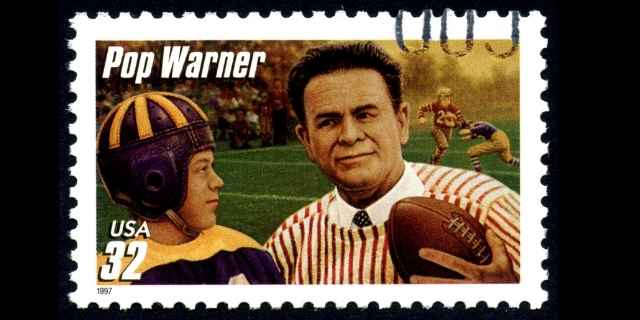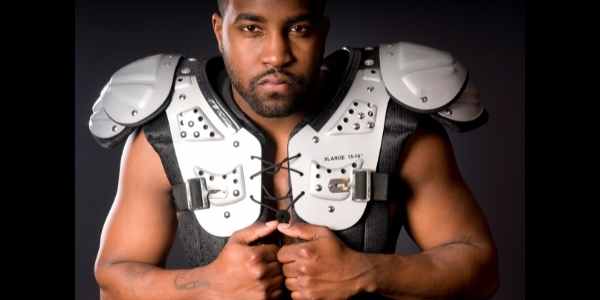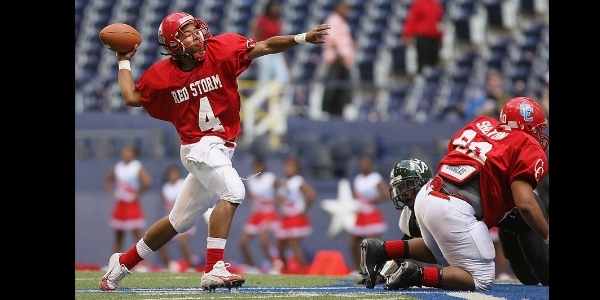One of the hallmarks of American football is the armored appearance of the players with their built-up shoulders.
But, have the players always looked like this? When did shoulder pads enter the American sport?
When Did American Football Players Start Wearing Shoulder Pads?
When the first football game was played in 1869 between Princeton and Rutgers, none of the players were wearing pads.
Leg padding appeared very quickly. This was the first introduction of pads into the sport.
The first shoulder pads did not appear until 1877.
Smock, inventor of the first shoulder pads (pillows)

The inventor of these pads was L.P. Smock. He was a Princeton student who had participated in the famous event that we consider the first American football game.
Check out our article on how American football began in the late 19th century.
Smock’s shoulder pads didn’t look much like the ones you see today.
They were little more than two leather and wool pillows that were stuffed (not sewn) under the shirt.
They were thin and provided very little protection. Smock’s goal was probably to reduce the immediate pain of impact.
First sewn shoulder pads
Smock’s version quickly evolved into a leather and wool pad that was sewn to the outside of the jersey.
The first official mention of these shoulder pads is in an 1899 book by Walter Camp (he is considered the father of the sport).
At first, any player seen wearing padding was likely to get mocking from friend and foe alike, but this soon changed.
As Walter Camp’s rule changes took effect and collisions became more frequent and violent, padding soon became standard.
Because blocking and tackling were done with the shoulders in those days, shoulder pads actually predate helmets.
Shoulder pads were initially mandated in the first decade of the 20th Century by Coach Pop Warner for his Carlisle Indian Industrial School teams.

During this decade there was a lot of experimentation with equipment.
Shoulder pads might be padded jackets, the sewn-on shoulder pads with a thigh pad sewn over the collar bone, or any one of several other contraptions.
Some were just padded collars that covered the collar bone but did nothing to protect the shoulder joint.
Evolution Of Shoulder Pad Design
The ancestral design of the modern shoulder pad was patented in 1906 by Abraham Schemel.
He called it a “Jacket For Football-Players”.
Schemel’s “Jacket For Foot-Ball Players”
The jacket covered both the collar bone and the cap of the shoulder joint like the modern pad.
It consisted of a short, flexible, padded leather vest that laced over the chest and covered the collar bone.
There were rigid, molded shoulder cups made from the same thick leather that is used for shoe soles.
The shoulder cups could move independently of the vest. This made them far less restrictive than earlier styles.
Schemel never licensed or mass-produced his model. He only produced them himself and sold them to a few colleges.
Spaulding QS3
Schemel’s patent expired in 1921.
The Spaulding company immediately started mass producing Schemel’s design.
They called it the Spaulding QS3.
Goldsmith’s Protective Football Harness
Goldsmith introduced their “protective football harness” in 1927.
This design eliminated the underarm strap and added elastic straps to hold the chest piece in place.
This is the basic design that still exists in modern times.
From here, the only major change would be materials.
Evolution Of Materials
While the shoulder pad was mandated by some teams, many players still did not wear them until the 1950s.
This was because the leather materials made them bulky, heavy, and poorly ventilated.
In the 1940s and 50s, leather began to be replaced by plastic. This made shoulder pads lighter and more breathable. Finally, their use became universal.
In the 1960s, synthetic foam padding came into common use and this made them even lighter and more protective.
Current materials
In the 2000s, composite materials have replaced plastic.
This means the pads continue to get lighter and more protective.
For a while, there were even shoulder pads that had attachments for a cold air hose to cool players down when they came off the field!
Different Pads For Different Positions

Shoulder pads aren’t a one-size-fits-all kind of gear. They come in different sizes depending not just on the player’s size, but on the position they play.
Offensive linemen don’t need to be able to lift their arms over their heads. So pads designed for them may be bigger and much more rigid than those for a quarterback or a receiver.
A quarterback’s pads must allow absolutely unhindered arm movement. But they may have rib protection attached to the bottom since quarterbacks are prone to be hit while standing tall, trying to throw a pass.
A kicker’s shoulder pads are tiny. They basically exist to satisfy the rules that everyone must wear shoulder pads.
Why Have Shoulder Pads Become Smaller Over Time?
The size of shoulder pads has changed over time as well.
The early pads that were sewn onto or stuffed into a shirt were very small.
While the hardened leather shoulder pads were bigger, weight still limited how big they could be.
Getting bulky
With the advent of foam and plastic construction, a lot of positions started wearing huge shoulder pads. This includes lineman, linebackers, and fullbacks.
Lineman’s pads often had plates that extended down to the solar plexus. The pads could even have neck rolls attached to limit head movement.
Getting smaller
Oddly enough, recently things have gone in the opposite direction.
If you look at an NFL game now, then look at one from the 1980s or 1990s, one thing becomes immediately apparent.
The players now are wearing much less padding, and what they are wearing is smaller.
You no longer see the neck rolls, the massive shoulder pads, the hand and forearm guards, or even big thigh or hip pads. What happened?
What happened is that the rules have changed, and the padding has changed with it.
Just as Walter Camp’s rule innovations caused the increase in padding, the new rules are causing its decrease.
Rule Changes Have Led To Smaller Pads
In the last few years, the NFL has changed its rules to enhance the offense. This was specifically to enhance the passing game.

The pounding ground game of prior eras is a rarity now.
With these new rules, the absolute premium is speed. Players will do anything to get a perceived speed advantage.
Receivers’ shoulder pads are now little more than a harness that holds a composite cup over their shoulder joint.
Defensive backs who must keep up with them have reduced to match.
It is not uncommon to see defensive linemen wearing shoulder pads that were meant for kickers.
The minimal pads ethic is so strong that the NFL actually had to recently mandate thigh pads and knee pads because no one was wearing them voluntarily anymore.
Even offensive linemen have less need for big shoulder pads because pass blocking is now done with the arms extended.
If shoulder pads weren’t mandatory, a lot of players probably wouldn’t be wearing them at all!
Other Football Equipment
Football comes with other equipment that has changed from the early days.
Check out our article on the history of American football helmets.
What About Rugby?
On this website, we like to compare and contrast American Football to its cousin, rugby.
Some rugby players also wear shoulder pads, but it’s not mandatory. And they tend to be smaller than in gridiron. Why is that?
Check out our article on shoulder pads in rugby.